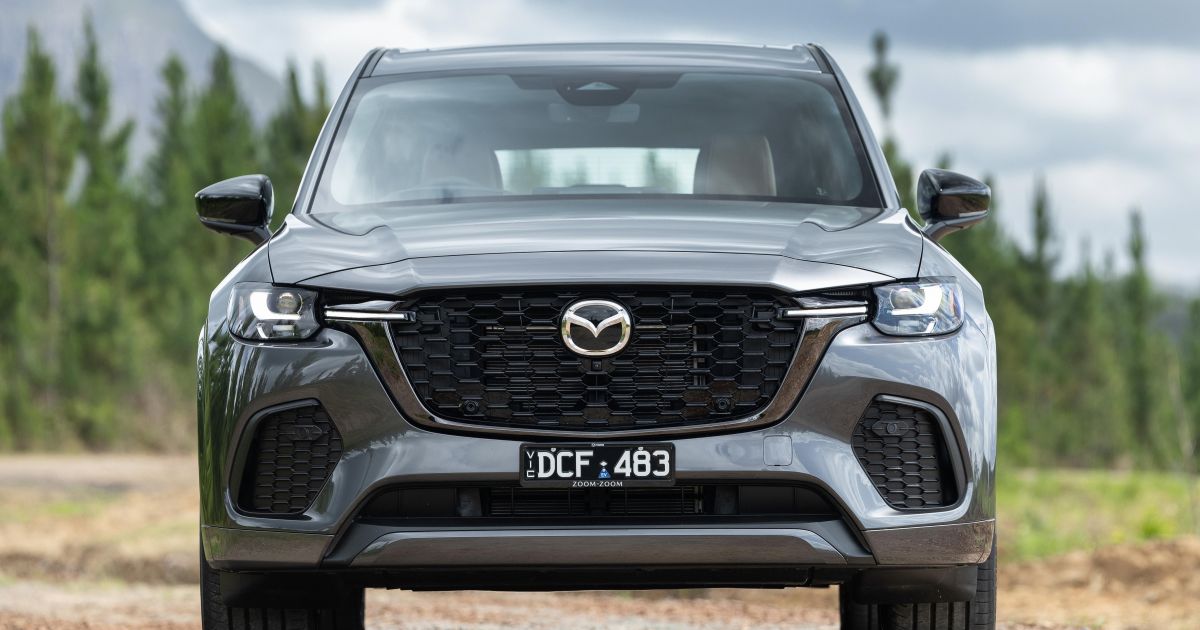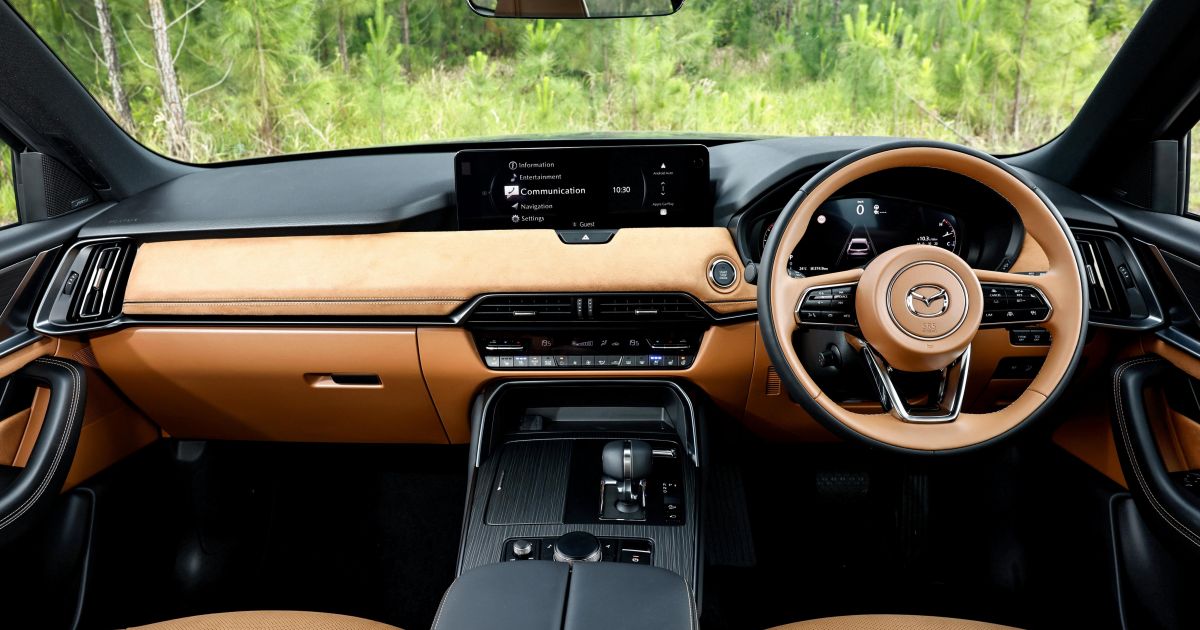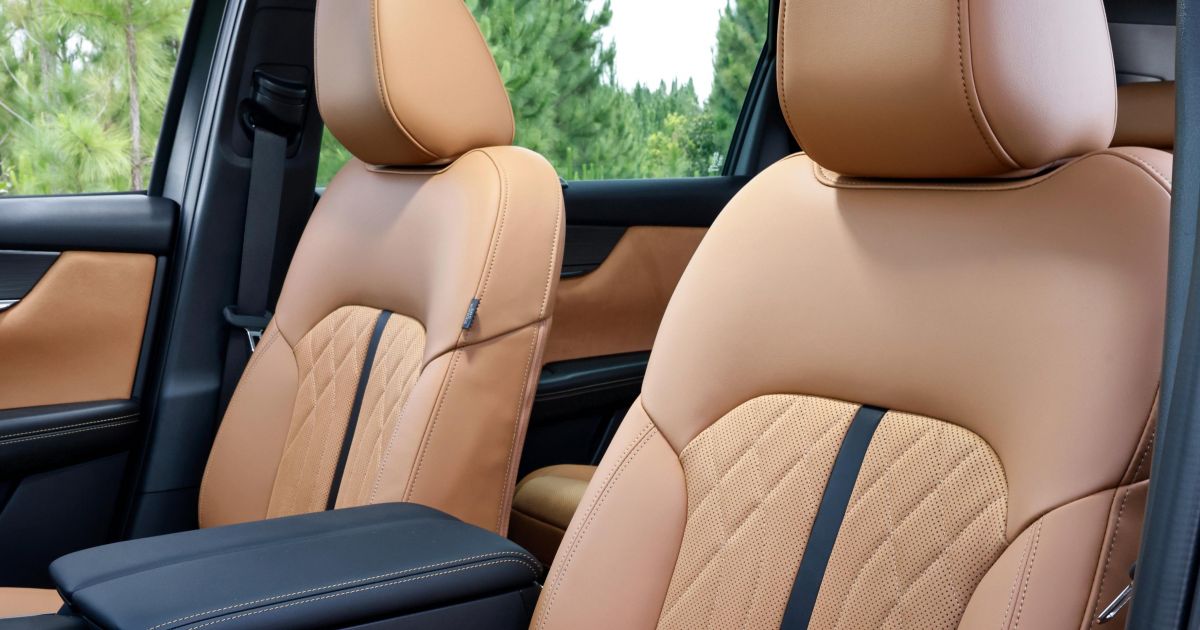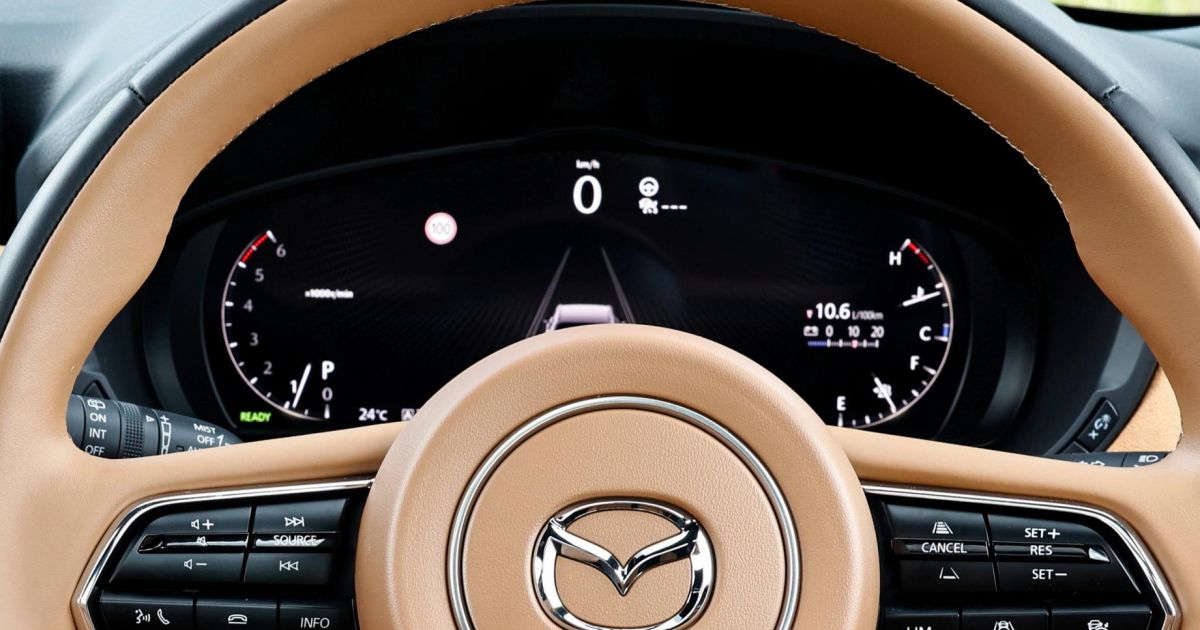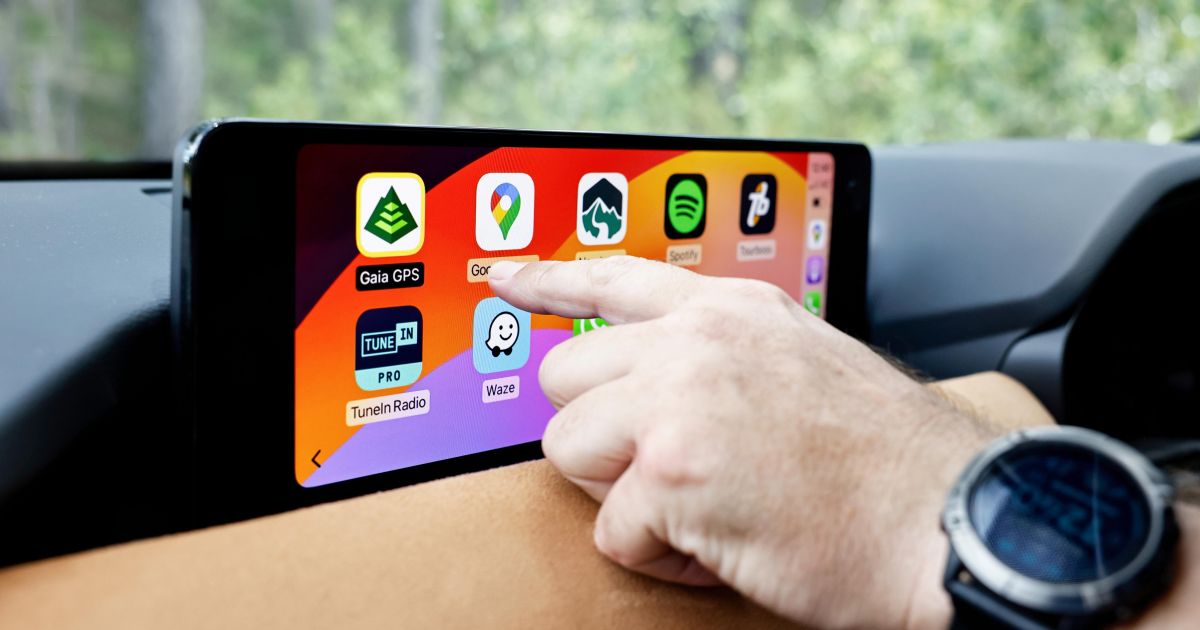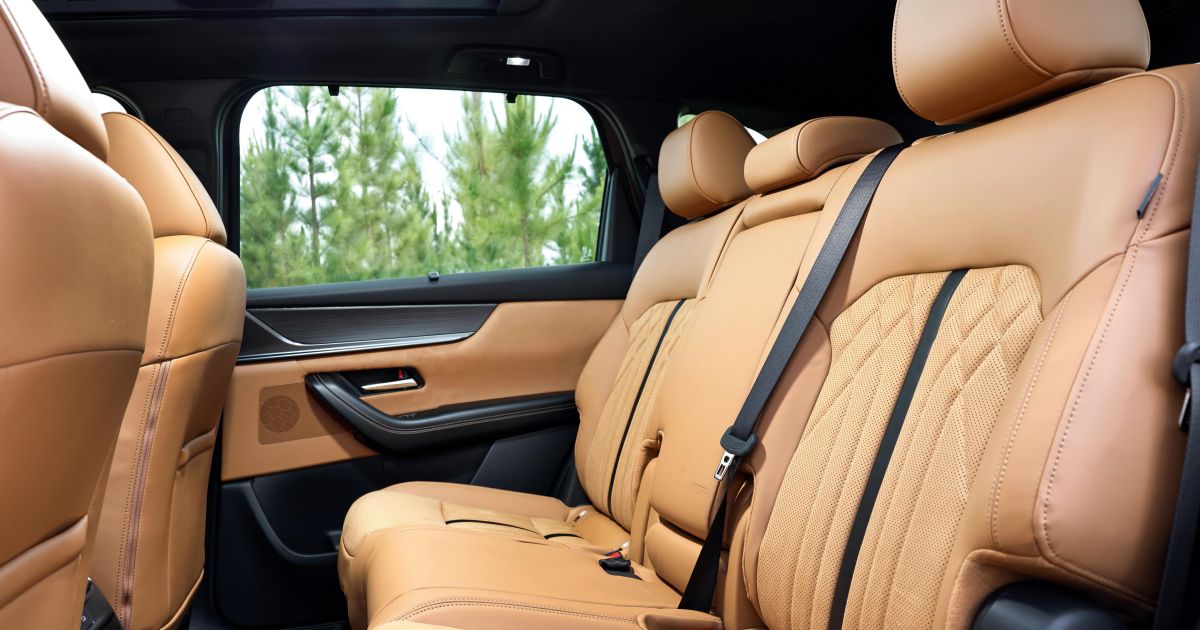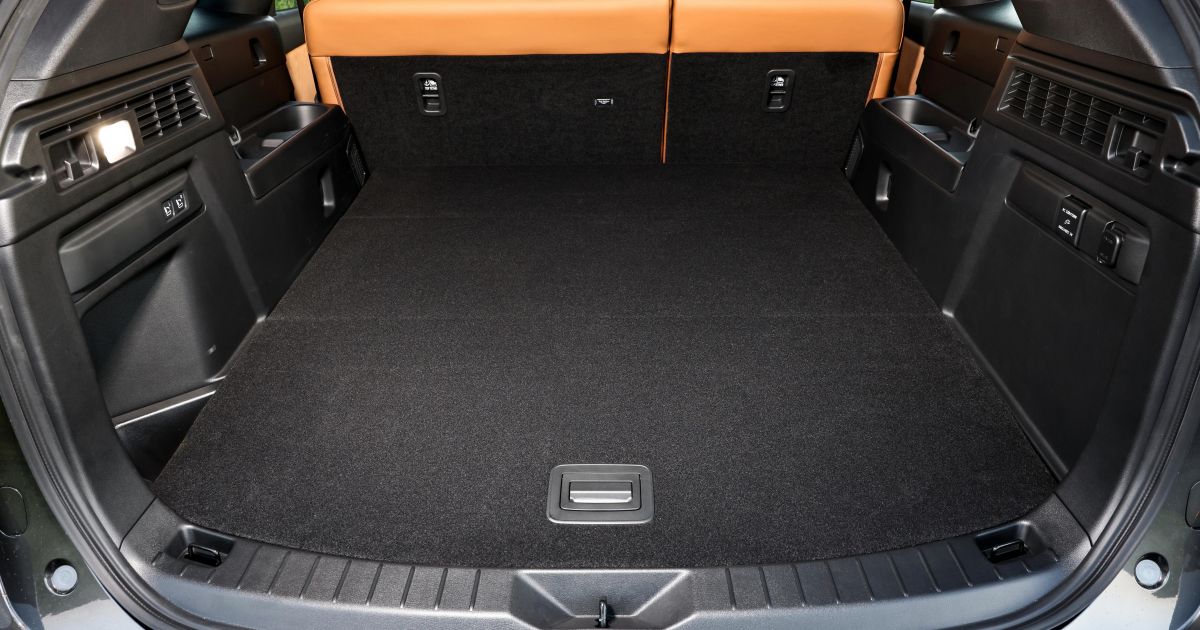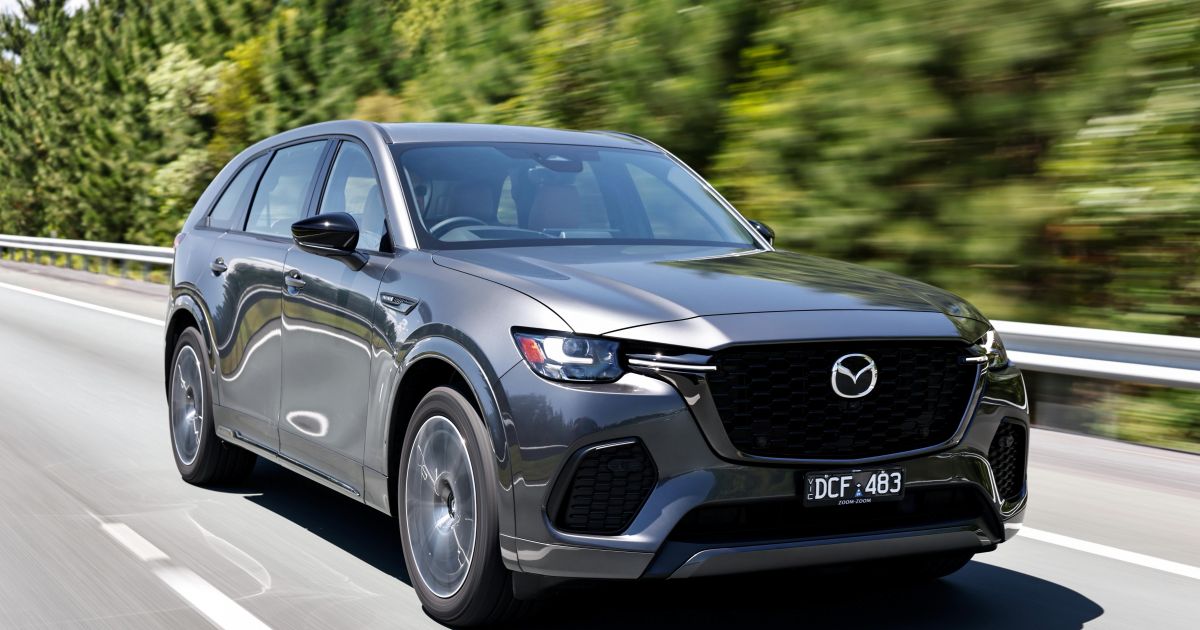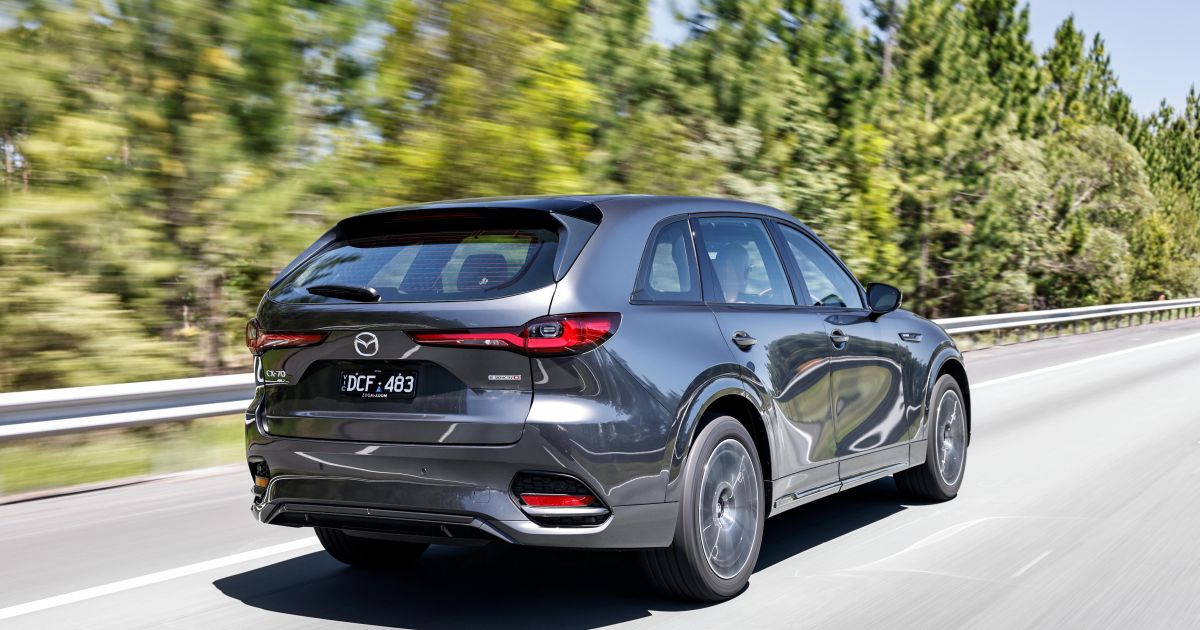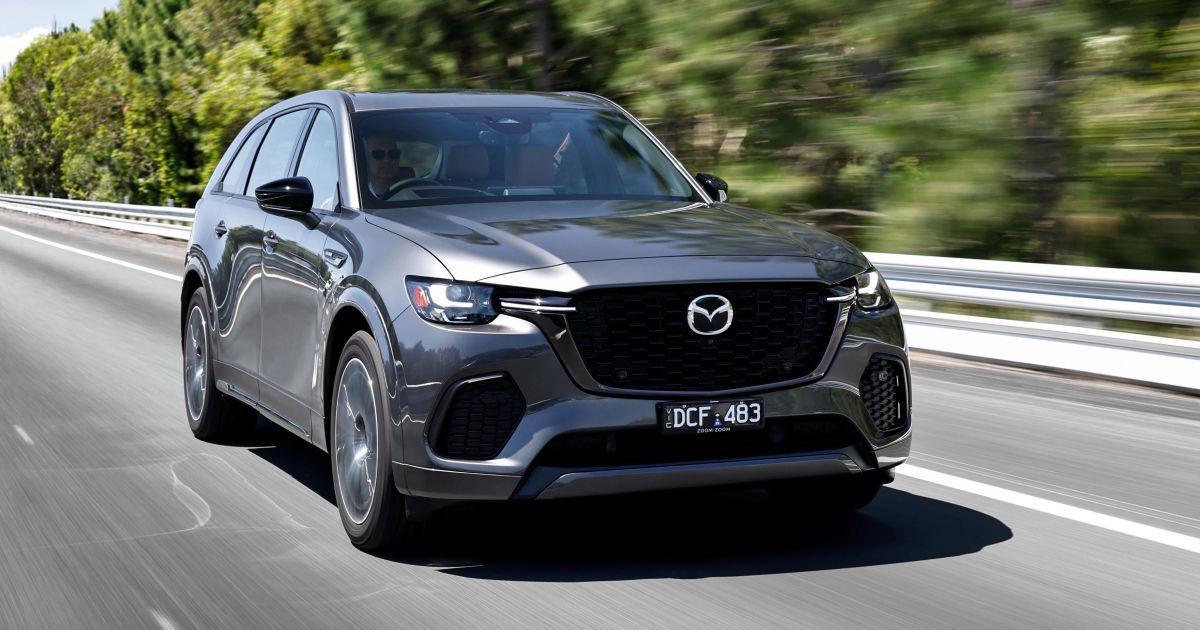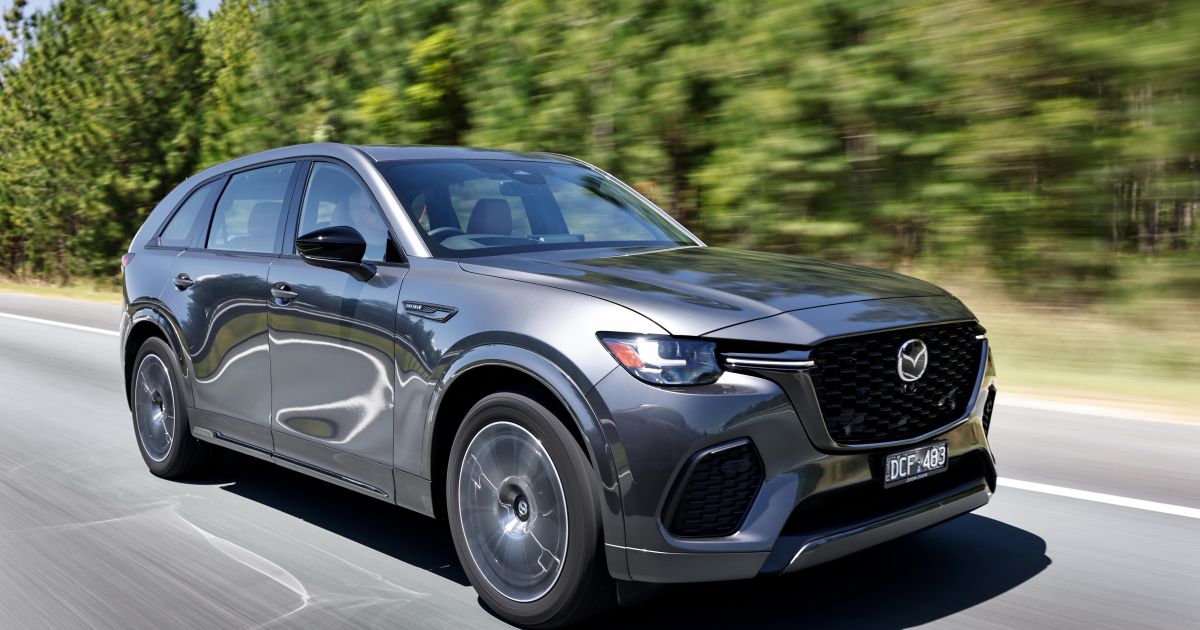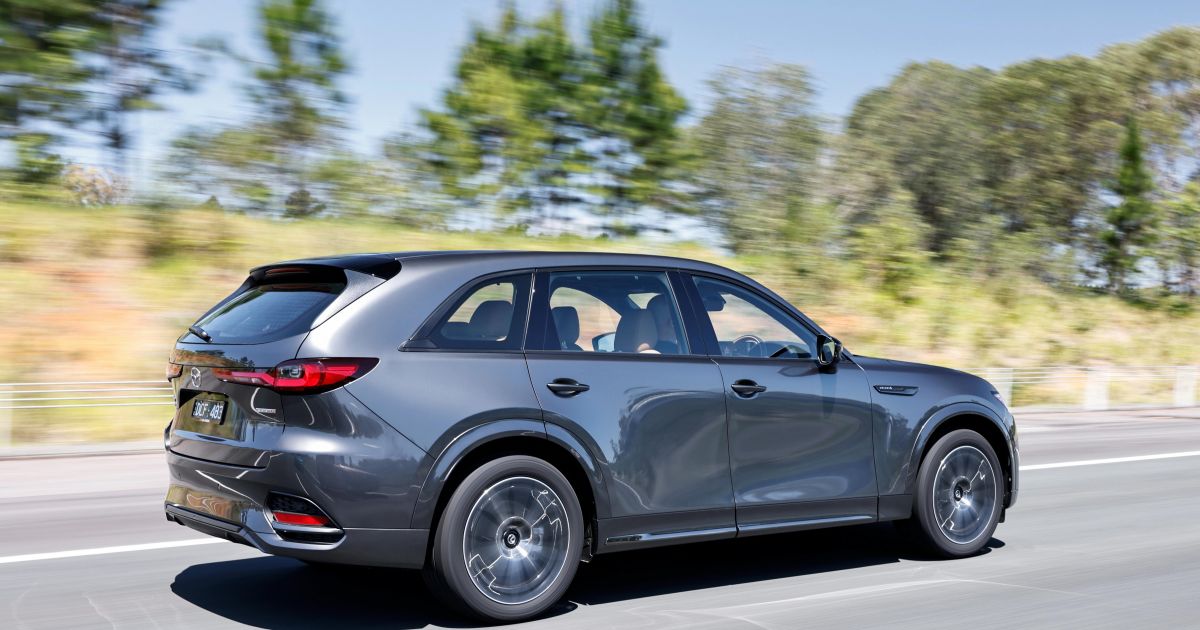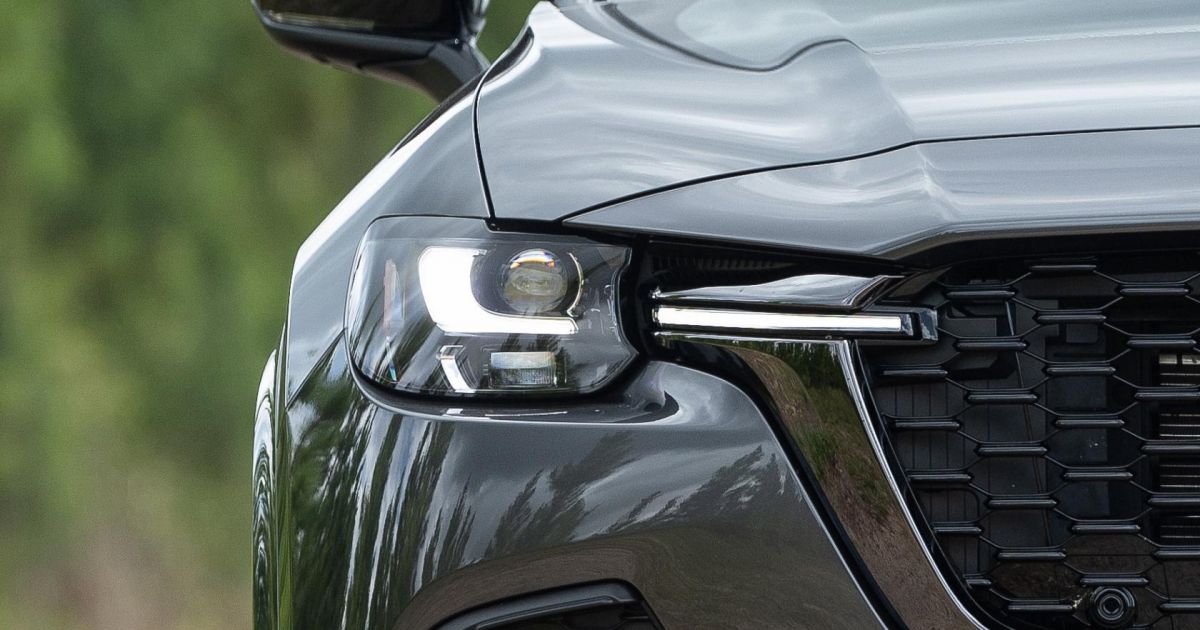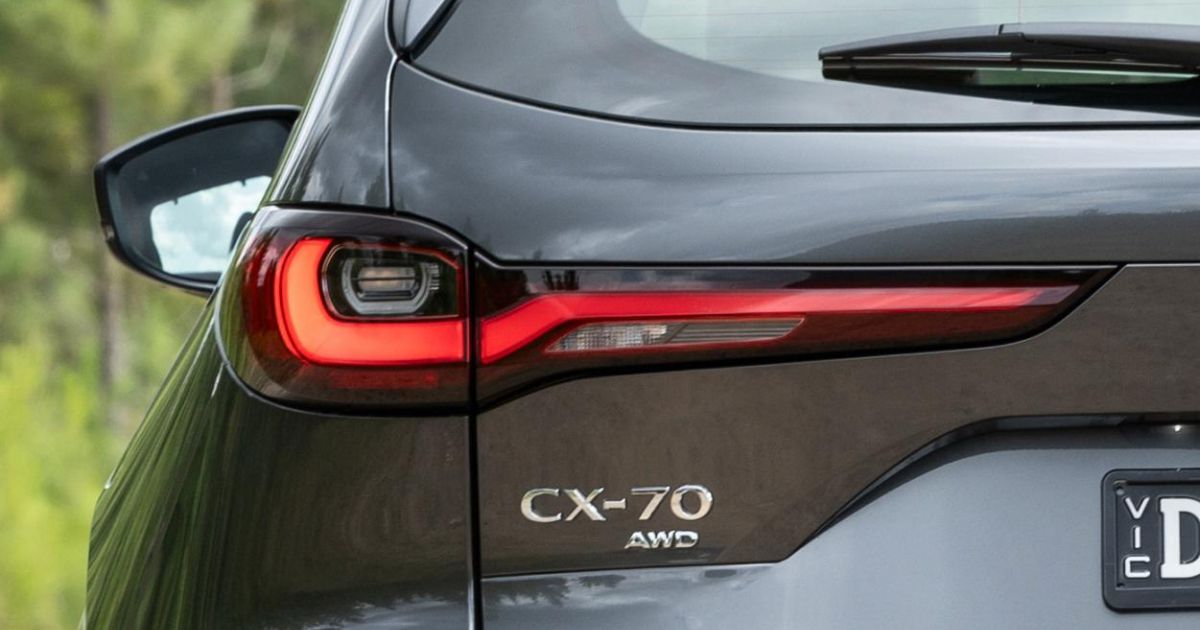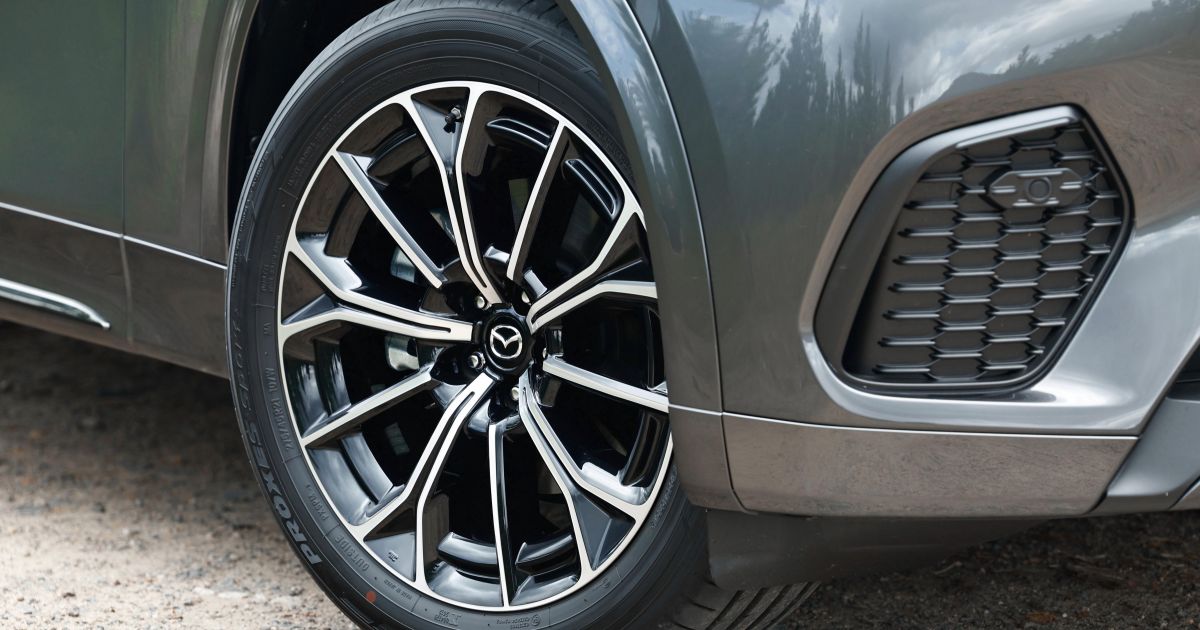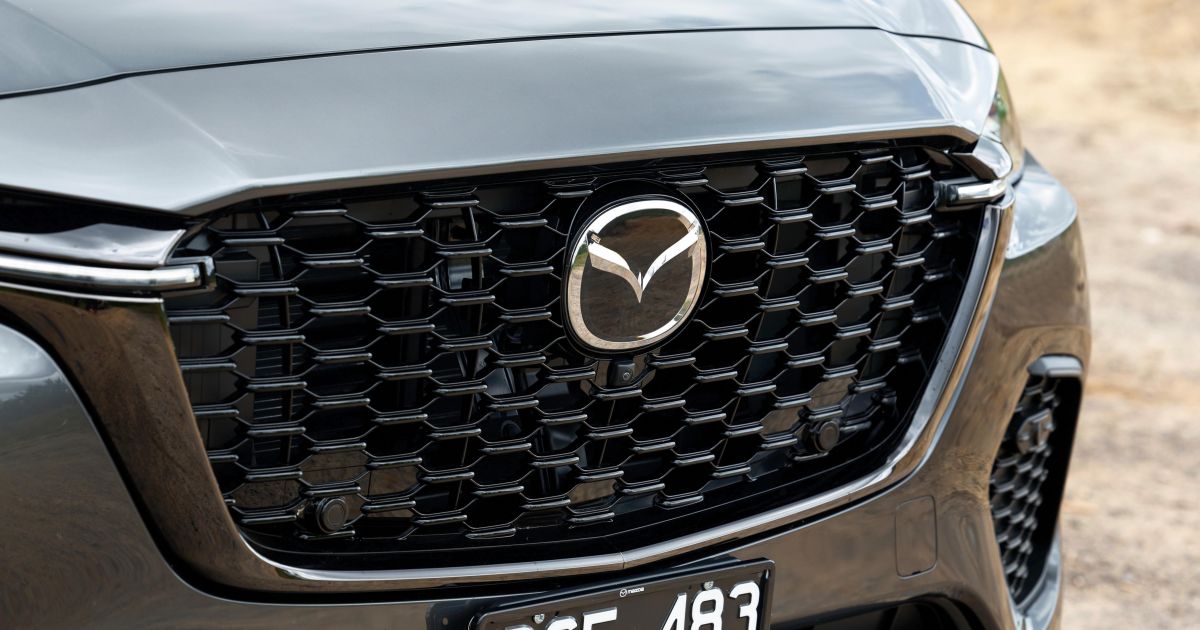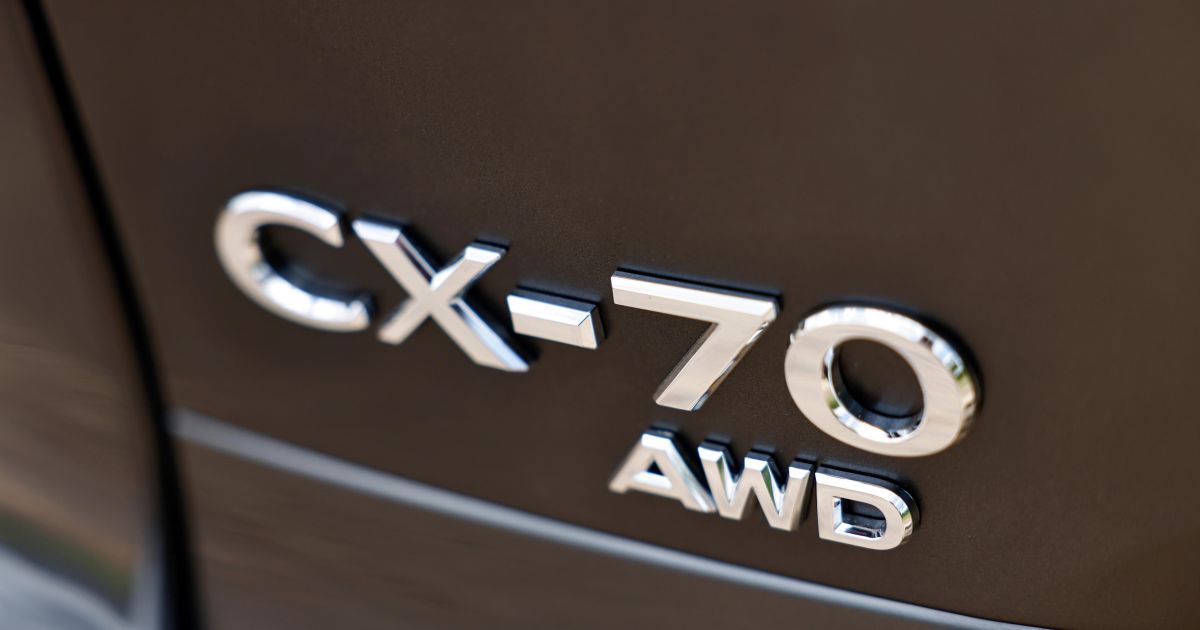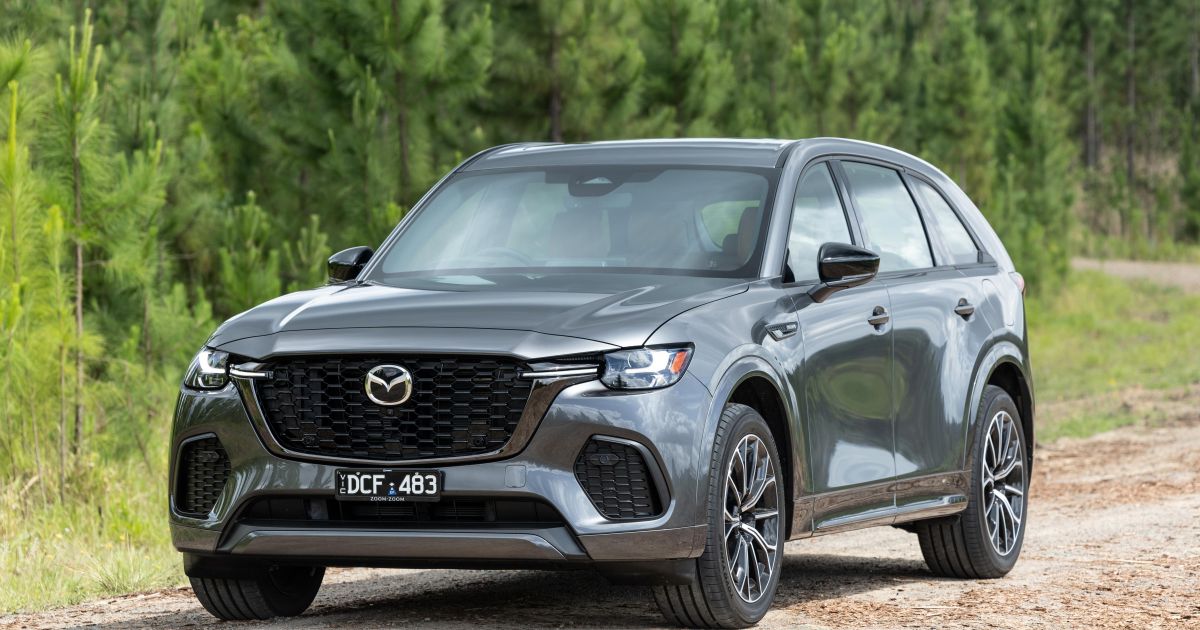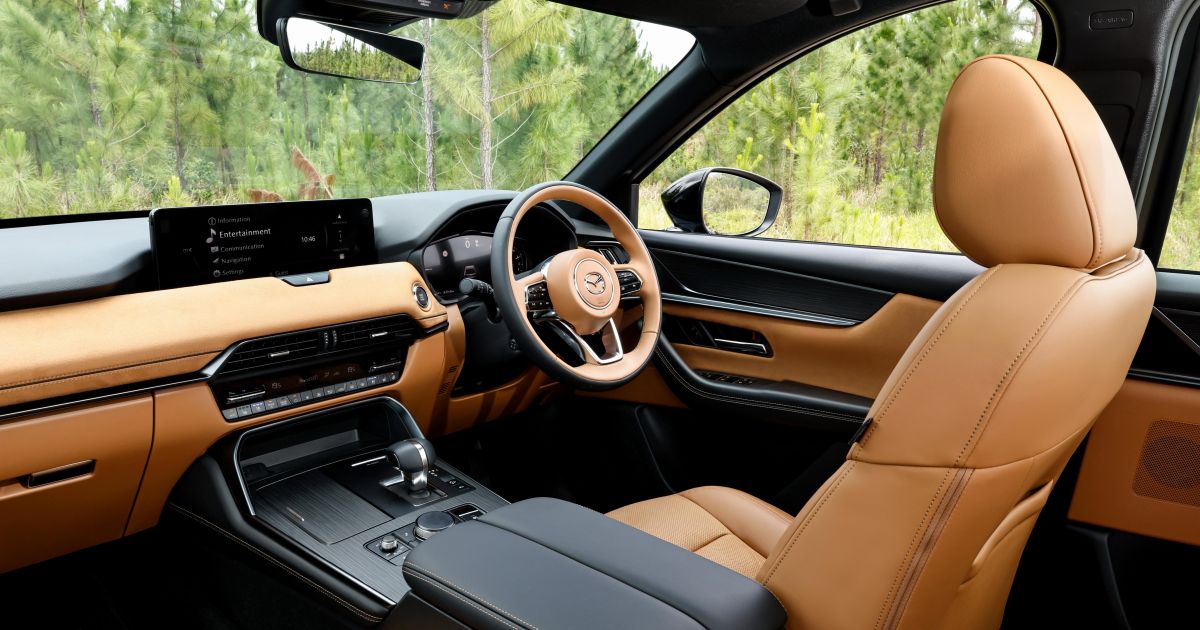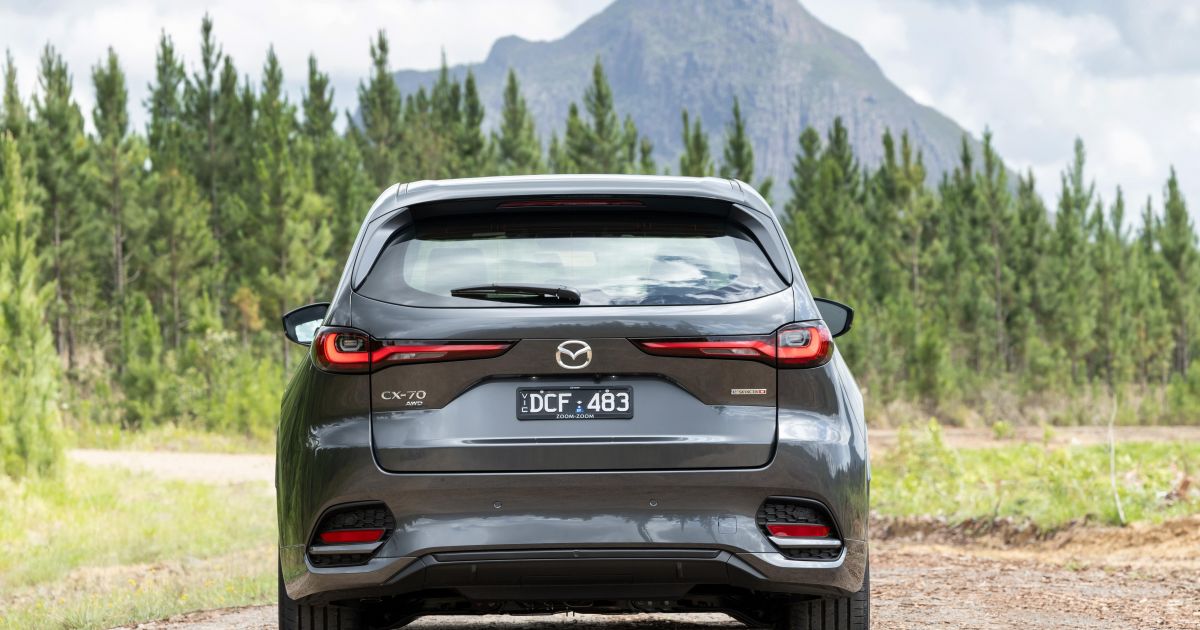Mazda’s SUV lineup has certainly ballooned in the last year or so, and the latest additions round out its more upmarket model based on the Japanese automaker’s rear/all-wheel drive Large Product Group platform architecture.
-
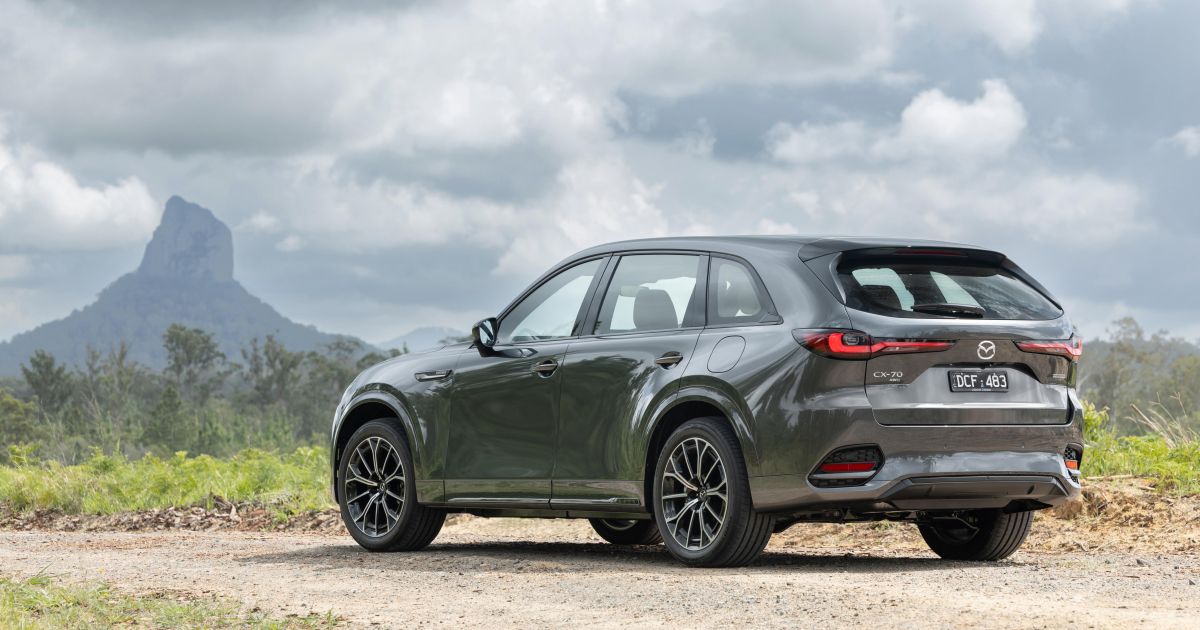
D50e Azami shown throughout
The Mazda CX-70 large SUV is a North American-focused vehicle that’s essentially a five-seat version of the ‘wide-body’ CX-90 seven-seater, which has been on sale locally now for two years.
The two SUVs share their external footprints, and even their interiors are similar. The main difference is that the CX-70 doesn’t have a third row of seating and naturally has a larger boot with all the seats upright.
Slotting above the mid-size CX-60 five-seater, which forms the basis of the ‘narrow-body’ CX-80 seven-seater, the CX-70 is Mazda Australia’s flagship two-row SUV.
WATCH: Paul’s video review of the 2025 Mazda CX-70 G50e Azami
The Australian market is unique in getting all four of Mazda ‘Large Architecture’ SUVs – the CX-60, CX-70, CX-80, and CX-90. In fact, we’re the only right-hand drive market to get the CX-70. It’s not even available in New Zealand or Japan, where the car is made.
Currently, the CX-70 is only offered in two trim levels – GT and Azami. On test here is the top-spec Azami trim with the optional SP Package and the G50e inline six-cylinder petrol engine.
With four luxurious SUVs now on sale in Australia, does the Mazda CX-70 firm as the pick? Read along to find out.
How much does the Mazda CX-70 cost?
On test here is the flagship petrol-powered CX-70 Azami variant with optional SP Package, which costs an additional $3500. As tested, this car costs $98,075 drive-away for Victorian buyers.
| Model | Price before on-road costs |
|---|---|
| 2025 Mazda CX-70 G50e GT | $76,220 |
| 2025 Mazda CX-70 D50e GT | $78,220 |
| 2025 Mazda CX-70 G50e Azami | $84,016 |
| 2025 Mazda CX-70 D50e Azami | $85,220 |
To see how the Mazda CX-70 lines up against the competition, check out our comparison tool
What is the Mazda CX-70 like on the inside?
There’s no denying this car is properly plush inside, especially with the optional SP Package. It rivals the likes of many German luxury brands in terms of presence, equipment and fit and finish.
This car feels distinctly American, however, as evidenced by the wide centre tunnel and split centre armrest. As a result, it feels like the front passenger is in a different post code.
The suede sections on the dashboard in particular feel special. You’re able to do that thing where you rub it in the opposite direction, and it looks different. What can I say? I’m a child at heart.
There’s also a bucket-load of soft-touch finishes, which further makes the car look and feel more premium, but while you need to look hard to find harder plastics, they do exist.
It’s easy to hop into this car due to its raised ride height, which is synonymous with crossover SUVs. Once you’re in, the driving position is commanding, yet sunken into the car rather than feeling perched within it as with some rivals.
The seats are deliciously clad in tan Nappa leather upholstery, though the driver’s seat feels a little firm and flat. You can tell it’s oriented at the US market, where they typically have larger waistlines.
As standard, the seat offers 10 ways of electric adjustment, which is very generous and allows people of all different sizes and statures to dial in their desired seating position. In fact, you can even set up a profile in the car and input your height, and it’ll automatically adjust the seat and steering wheel position.
I particularly like how much under-thigh support you can dial in. This is great for those with longer legs, like myself.
Ahead of the driver, the two-tone steering wheel is beautiful to look at and to hold. The electric steering column adjustment feels fancy for a premium-pushing mainstream car.
All the buttons on the steering wheel are logically placed and have a delightfully clicky action that makes them fun to interact with. They also have a satin finish that doesn’t attract fingerprints like the ones with glossy piano black buttons.
Behind this is a 12.3-inch digital instrument cluster, which is large and bright. However, the user interface is rather dark, and there’s lots of unoccupied space, which feels wasteful. It’s also a little disappointing that there’s minimal configurability. The Germans do instrument clusters much better.
On top of the dashboard, there’s a bright and clear head-up display that tells you all you need to know at a quick glance. Unlike some head-up displays from other brands, it shows upcoming giveway and stop signs, as well as signposted speed limits.
Moving across, there’s a large 12.3-inch infotainment system that runs the same Mazda Connect software as other current Mazda models. It’s fine, but like the digital instrument cluster, the user interface is dark, and there’s heaps of dark space. It just feels like a missed opportunity.
To navigate the native user interface, you’re forced to use the rotary dial on the centre console. It feels old-school in 2025, but it can allow you to keep a closer eye on the road while navigating menus. However, it does get frustrating while scrolling through lists, for example.
As standard, there are wired and wireless forms of Apple CarPlay and Android Auto. With my iPhone 15 Pro Max connected wirelessly, I didn’t experience any dropouts whatsoever.
You’re able to tick an option box on the infotainment system that allows you to utilise touch functionality during smartphone mirroring. It would be great if this was on by default, as navigating CarPlay with the rotary dial can be a big pain.
Complementing the wireless smartphone mirroring is a wireless phone charger at the front of the centre console. It’s tucked away nicely, though there aren’t any bumpers to secure your phone in a specific spot. As a result, my phone would sometimes get hot as the charging coils weren’t aligned.
I appreciate the physical climate control cluster as it’s very easy to change things like the temperature, fan speed, and where the air is blowing. It’s a minor thing, but I also liked the fact there are no blank buttons in this flagship Azami model.
Up-front storage is adequate, which feels a little like a letdown because this car is big. Highlights include two cupholders, as well as a decently sized centre console box and glovebox.
Moving to the second row, the CX-70 continues to shine. Like many Mazda SUVs, the rear doors open to almost 90 degrees, which makes loading kids and stuff in much easier.
Once you’re in, there is so much space. At a leggy 182cm, I had oodles of room behind my own driving position, plus you can slide and recline the second-row bench to further improve comfort.
You could easily go three abreast in this car due to how wide it is, however, middle-seat passengers have to contend with a big transmission hump.
Second-row amenities include heated outboard seats, rear air vents with a separate climate zone, USB-C ports, and a fold-down centre armrest with cupholders.
Around the back, there’s a power tailgate that, naturally, has a hands-free function. This is handy if you need to open the boot with your hands full. I do wish the tailgate itself would open just a tad higher, however, because I almost hit my head on it a few times.
Once the tailgate is open, you see the boot is ginormous. The main boot area itself is very large, and underneath the floor panels there are additional underfloor storage cavities. This is handy if you’re needing to stow something out of view.
Something you’ll note in the boot in the third-row cupholders haven’t been removed, which means this car really is a CX-90 without the third row. Of course this was easier for Mazda than creating a new cargo compartment design, but on the other hand it seems a bit lazy.
Boot-related amenities include a retractable cargo cover, light, 12V socket, and a 150W AC power outlet. There are also bag hooks and buttons to fold down the second-row seats in a 60:40 configuration.
This car has a space-saver spare wheel, which is surprising given it is a mild-hybrid. Typically, these kinds of cars have a high-voltage battery pack where the spare wheel normally resides. It’s not as good as a full-size spare, but it’s still great peace of mind if you frequently do long-distance travel and experience a puncture along the way.
| Dimensions | Mazda CX-70 |
|---|---|
| Length | 5120mm |
| Width | 1994mm |
| Height | 1745mm |
| Wheelbase | 3120mm |
| Cargo capacity | 598L (5 seats) 2015L (2 seats) |
To see how the Mazda CX-70 lines up against the competition, check out our comparison tool
What’s under the bonnet?
The CX-70 G50e is powered by a 3.3-litre turbocharged inline six-cylinder petrol engine with 48V mild-hybrid assistance. It’s the same tune the CX-90 G50e gets.
| Specifications | CX-70 G50e |
|---|---|
| Engine | 3.3L 6cyl turbo-petrol |
| Power | 254kW @ 5000-6000rpm |
| Torque | 500Nm @ 2000-4500rpm |
| Transmission | 8-speed auto |
| Drive type | AWD |
| Weight | 2198kg |
| Fuel economy (claimed) | 8.1L/100km |
| Fuel economy (as tested) | 10.0L/100km (300km) |
| Fuel tank capacity | 74L |
| Fuel requirement | 95-octane premium unleaded |
| CO2 emissions | 189g/km |
| Emissions standard | Euro 5 |
| Braked tow capacity | 2500kg |
To see how the Mazda CX-70 lines up against the competition, check out our comparison tool
How does the Mazda CX-70 drive?
Pressing the starter button on the dash sees the straight-six petrol engine roar to life. Like many Mazdas, it flares the revs up to 2000rpm when cold, then settles into a gruff idle that doesn’t go away until the engine warms up. It’s something that you learn to love about Mazdas.
Setting off, you need to acquaint yourself with the gear selector. It’s fairly self-explanatory, but you need to push it across to the left before shifting into drive or reverse.
This turbo-petrol inline-six is a sweet unit that’s willing to rev to get this circa-2.2-tonne beast moving. In this respect, it reminds me of BMW’s architecturally similar B58 engine.
There’s also plenty of power and torque on tap. Peak torque comes on tap from just 2000rpm, which is handy as the car doesn’t need to downshift as often when more acceleration is called upon.
There were many moments where I was cruising at around 50km/h, and the car was revving just above idle (~1000rpm) in a high gear, and I could accelerate away without dropping a gear. This is something you’d typically only experience in a torquey diesel-powered car.
While this CX-70 is already pretty swift in its default normal mode, flicking into Sport mode makes it a formidable big beast. You’ll easily be keeping up or even pulling ahead of traffic at the lights. It just leans back and pulls.
Assisting with this effortless urge is a 48V mild-hybrid system. It can help contribute some additional oomph during acceleration and take some load off the engine in other situations.
Additionally, the mild-hybrid system allows for a more active engine idle stop/start system. It’s seamless for the most part and allows the engine to be switched off for longer, though during our testing the engine would switch back on after 15-20 seconds of being stationary. In all fairness, we did have the air-conditioner cranking.
The start/stop system can also activate while you’re coasting to a halt or when you’ve let off the throttle for periods of time. In fact, it will often shut the engine off around 50-60km/h when coasting, especially downhill, but when you accelerate again it can be jerky and take a second to deliver quicker progress.
It doesn’t help that the eight-speed automatic transmission can sometimes be a little stuttery. Mazda has clearly been working away with the calibration as it worked better than in previous CX-60s I’ve driven, though you still need to learn how to drive it.
Despite the mild-hybrid intervention, urban fuel consumption in this vehicle still sits around 10L/100km. That’s a lot, but you also need to keep in mind that this is a large SUV with a six-cylinder engine.
Around town, the CX-70 feels like a big American car. It seems like there is little space left between it and your lane markings either side, and parking can sometimes be a hassle as the long bonnet may hang out of small parking spots.
Thankfully, there are front and rear parking sensors, as well as a surround-view camera. The latter is a godsend in a vehicle like this, so it’s great that it’s standard across the entire CX-70 range.
While the CX-70 does feel distinctly American, its chassis isn’t overly soft. In fact, it’s the opposite. The steering is rather firm, like in many Mazdas, making three-point turns and even driving in tight spaces somewhat of an arm workout, which could become tiresome.
The suspension is also on the firmer side, but lumps and bumps are well isolated and not transmitted into the cabin. It’s much more serene and comfortable than previous CX-60s I’ve driven.
Out on the open road, this car settles beautifully into high-speed cruising. The car slots into top gear and won’t budge unless you want to do a brisk overtake or meet a steep hill.
The ride remains compliant and doesn’t get too busy or choppy, and the steering makes piloting this large SUV almost smile-inducing.
If you solely drive on the highway, the inline-six diesel option might be the better option for you as it has more torque and feels even more effortless at speed, but it’s not as sweet as the petrol six when revved out. Horses for courses.
Although this car drinks petrol like there’s no tomorrow around town, it achieves almost diesel-like fuel economy at higher speeds. There were many times during my time in it that I saw instant fuel consumption readouts of 5.0L/100km at 100-110km/h.
On the safety front, the CX-70 Azami is fully loaded. The adaptive cruise control is good at managing a safe distance between you and the car ahead, while not getting overwhelmed and slamming on the brakes when a car travelling slightly slower than you cuts in front.
The lane-keep assist is generally good and sometimes gets a bit of a workout in such a wide car. On freeway offramps, however, the system can get confused and try to steer you into a lane that doesn’t exist. Many cars struggle with this, even on roads with clearly marked lanes.
Then there’s the lane centring function, which works in conjunction with adaptive cruise control but is best left for well-marked highways and freeways as the steering inputs were sometimes a little too hands-on for my liking.
Lastly, the adaptive LED headlights are bright and great for rural driving, as you can keep your high-beams on for as long as possible. This means you’ll be able to spot any obstacles quicker than you would with dipped lights.
To see how the Mazda CX-70 lines up against the competition, check out our comparison tool
What do you get?
Unlike the CX-90, there are just two trim CX-70 levels available – GT and Azami – though the latter can be had with an optional SP package.
Mazda CX-70 GT equipment highlights:
- 21-inch black alloy wheels
- Space-saver spare
- Power-folding, heated exterior mirrors with memory
- Adaptive LED headlights
- Rain-sensing wipers
- Rear intermittent wiper
- Panoramic sunroof
- Hands-free power tailgate
- 12.3-inch infotainment screen
- Wireless and wired Apple CarPlay and Android Auto
- DAB+ digital radio
- Satellite navigation
- 12.3-inch digital instrument cluster
- Head-up display
- 12-speaker Bose sound system
- 10-way power driver’s seat with two-position memory
- 8-way power passenger seat
- Heated front seats
- Heated outboard rear seats
- Heated steering wheel
- Leather upholstery
- Leather-wrapped steering wheel and shifter
- Tri-zone climate control
- Personalise system (auto restoration of settings)
- Electric parking brake with auto hold
- Electric steering wheel adjustment
- Hill descent control
Azami adds:
- Body-coloured wheel arches, lower cladding and door handles
- Ventilated front seats
- Nappa leather upholstery
- Ambient lighting
- Interior ‘foot lamp’ (front and rear)
- Frameless interior mirror
- Personalise system with Easy Entry & Driving Position Guide
SP Package ($3500, Azami) adds:
- Tan Nappa leather upholstery
- Suede dashboard panel
- Two-tone steering wheel
To see how the Mazda CX-70 lines up against the competition, check out our comparison tool
Is the Mazda CX-70 safe?
The Mazda CX-70 hasn’t been crash-tested by ANCAP yet.
Standard safety equipment includes:
- Adaptive cruise control
- Autonomous emergency braking (AEB)
- Pedestrian and cyclist detection
- Reverse AEB
- Junction assist
- Blind-spot monitoring
- Driver attention monitoring
- Front cross-traffic alert
- Rear cross-traffic alert
- Emergency lane-keep assist
- Lane-keep assist
- Safe exit warning
- Surround-view camera
- Front and rear parking sensors
- Traffic sign recognition
- Tyre pressure monitoring
- Front and front-side airbags
- Driver’s knee and far-side airbags
- Front and rear curtain airbags
Azami adds:
- See-through view for surround-view camera
- Cruising and Traffic Support
- Unresponsive Driver Support, which can alert a driver and slow and/or stop the vehicle if they don’t take action
All CX-70 vehicles come with Mazda Connected Services, which allow you to use the MyMazda app to remotely control the locks and lights. Other features in this suite include:
- Emergency SOS call
- Geofencing capability
- Curfew notification
- Vehicle locator services
- Stolen vehicle assistance
- Vehicle status and health
To see how the Mazda CX-70 lines up against the competition, check out our comparison tool
How much does the Mazda CX-70 cost to run?
The Mazda CX-70 is covered by a five-year, unlimited-kilometre warranty.
| Servicing and Warranty | Mazda CX-70 G50e |
|---|---|
| Warranty | 5 years, unlimited kilometres |
| Roadside assistance | 5 years |
| Service intervals | 12 months or 15,000km |
| Total estimated service cost | $4763 (7 years) |
| Total estimated service cost | $680.43 |
The fourth service, in particular, is expensive at $1349. Ouch…
To see how the Mazda CX-70 lines up against the competition, check out our comparison tool
CarExpert’s Take on the Mazda CX-70
The Mazda CX-70 is a beautiful car that truly elevates the Japanese brand in its premium push. It’s a proper Audi Q8, BMW X5, Mercedes-Benz GLE, and even Volkswagen Touareg rival on a (relative) budget.
This big, plush SUV is likely all the car that anyone will ever need, and then some. The interior in this Azami spec with the optional SP Package, in particular, looks and feels properly special.
Minor transmission quibbles aside, the inline petrol six is a gem and so torquey. I’d personally opt for the diesel six as it’s even more effortless to drive, but both find a comfortable groove out on the open road.
I give Mazda credit for still developing big six-cylinder engines, which are rare now as most automakers downsize to meet stricter emissions targets.
But while the CX-70 is great, it also begs the question: Why not just get the CX-90 instead?
The boot space is pretty much identical with the first and second row of seats upright, and you also get the added flexibility of having third-row seats.
One of the main benefits is that the CX-70 is cheaper than the equivalent CX-90, but the reality is the price difference is only around $3000. It’s also worth noting that this car, as tested, costs almost $100,000 drive-away, so it’s far from what you’d call cheap.
Additionally, at this end of the SUV market, value is arguably less of a factor for many customers, and brand cachet means much more. This is why the German brands have such a strong hold here, even though some of their cars aren’t great packages.
If you’re willing to give a Mazda luxury SUV a try, this one won’t disappoint. If you need seven seats, the more expensive CX-90 could be for you. If not, take a CX-70 for a spin and you might be surprised at how European it feels, even if it is aimed at Americans.
Interested in buying a Mazda CX-70? Get in touch with one of CarExpert’s trusted dealers here
Click the images for the full gallery
MORE: Everything Mazda CX-70

